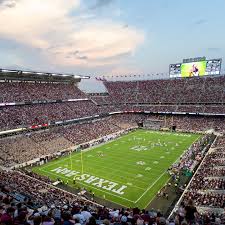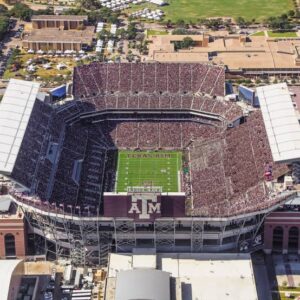
The expansion comes as part of a broader vision to modernize Kyle Field while preserving its storied traditions, including the deafening roar of the 12th Man. “Kyle Field is the heart of Aggieland, and this project ensures it remains the premier destination for college football,” said Texas A&M President Mark Welsh in a press conference. The plan includes adding approximately 12,000 seats, primarily in a new upper deck on the east side, alongside state-of-the-art amenities like expanded premium seating, upgraded concessions, and enhanced accessibility features.
Designed by architectural firm Populous, which led the $485 million Kyle Field redevelopment in 2015, the expansion will prioritize fan comfort and sustainability. New features include solar-powered concourses, advanced water recycling systems, and high-tech video boards to enhance the game-day atmosphere. The project also addresses long-standing fan requests, such as wider concourses to ease congestion and improved Wi-Fi connectivity to support mobile ticketing and in-game engagement. “We’re building for the future while honoring the traditions that make Kyle Field special,” said Athletic Director Trev Alberts.

The financial backing for the $175 million project comes from a combination of private donations, university bonds, and revenue from the SEC’s lucrative media deals. The 12th Man Foundation, Texas A&M’s athletic fundraising arm, has already secured $90 million in pledges from major donors, including a lead gift from an anonymous Aggie alumnus. “This is a testament to the passion of our fans,” said Ross Bjork, senior vice president of the 12th Man Foundation. “The 12th Man is stepping up to make history.”
Kyle Field’s expansion will push its capacity past Michigan Stadium’s 107,601, a title the Wolverines have held since 2010. The move has sparked excitement among Aggie faithful but also reignited rivalries, with some SEC fans questioning whether Texas A&M can consistently fill the expanded venue. In response, Alberts pointed to the Aggies’ unmatched home attendance, averaging 102,733 in 2024 despite a 7-6 season. “Our fans show up, rain or shine. The 12th Man doesn’t just fill seats—they shake the ground,” he said.
The project also holds economic promise for College Station. Local officials estimate the construction phase will create 1,500 jobs, while the expanded stadium could boost annual game-day revenue by $20 million for area businesses. “This is a win for Aggieland and the entire Brazos Valley,” said Mayor John Nichols. Hotels, restaurants, and retailers are already preparing for an influx of visitors drawn by the larger crowds.
However, the expansion has not been without debate. Some students and alumni expressed concerns about rising ticket prices and the potential impact on student seating allocations, which currently account for over 35,000 seats. University officials have pledged to protect the student experience, ensuring the Corps of Cadets and yell leaders remain central to game-day traditions. “The 12th Man starts with our students,” Welsh emphasized. “We’re committed to keeping Kyle Field accessible for them.”
Historically, Kyle Field has been a fortress for the Aggies, with only 12 home losses during R.C. Slocum’s 14-year tenure as head coach. The stadium’s intimidating atmosphere, fueled by synchronized crowd traditions like the “War Hymn” and midnight yell practice, has made it one of the toughest venues for opponents. The expansion aims to amplify that advantage, with acoustic engineers designing the new upper deck to trap sound and intensify crowd noise.
As Texas A&M prepares for its SEC schedule in 2025, the Kyle Field expansion signals the university’s bold ambitions on and off the field. With a new era under coach Mike Elko and a recruiting class ranked in the top five nationally, the Aggies are betting on a resurgence. “This isn’t just about a bigger stadium,” said Alberts. “It’s about building a program that competes for championships and a fan experience that’s second to none.
Be the first to comment